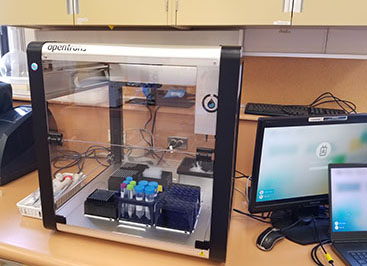Set up an interview
Media Relations
Agriculture and Agri-Food Canada
1-866-345-7972
aafc.mediarelations-relationsmedias.aac@agr.gc.ca
Food safety research has always been a high priority at Agriculture and Agri-Food Canada (AAFC), and it was imperative for research scientists to continue their work throughout the COVID-19 pandemic. During the past two years however, the pandemic challenged many research scientists in the agricultural sector to take a second look at their approaches to completing in-lab work while maintaining social distancing. On-site access to laboratory facilities is an important part of research activity, depending what is being studied. When access was not always possible, but the research needed to continue, some scientists adapted by getting inventive.
Drs. Justin Renaud and Mark Sumarah are two research scientists who put their heads together and rolled up their sleeves to customize a new robotic invention to assist with in-lab tasks. At AAFC’s London Research and Development Centre (LRDC), they analyze small organic molecules to detect and monitor fungal mycotoxins, which are contaminants that can occur in agricultural processes and food production. To do this important food safety work, liquid samples must be obtained from natural material.
Taking and analyzing samples takes time, of course, and access to lab equipment.
To complete samples on schedule without being on-site, the scientists, along with their team, procured an open-source robot geared towards genetic analysis tasks that can detect contaminants, such as mycotoxins, in liquid samples from natural materials. Natasha DesRochers, a key member of the London team, custom coded the software to allow the robotic liquid handler to process 200 liquid samples in a few hours, whereas, lab technicians and staff could process just dozens of these samples per day. With these samples, they can:
- perform trace level pesticide analysis
- extract mycotoxins from grain (complex food safety work that used to be a lengthy process)
This is the first robotic invention of its kind for the research centre and is considered a win-win for its cost effectiveness and ability to be customized.
"During pandemic lockdowns, it was important for everyone’s safety to only permit one research staff in the lab at a time, but research deadlines still needed to be met. We treated this challenge as an opportunity to think about how we could refresh our approach to completing lab tasks and our custom-coded robotic liquid handler is the result. It’s been a silver lining of the pandemic."
- Dr. Justin Renaud, Research Scientist, Agriculture and Agri-Food Canada
It’s an invention that can pave the way for future in-lab applications that can not only help alleviate social distancing challenges, but perform time-sensitive tasks with greater efficiency. Future applications may include the automation of polymerase chain reaction analysis, fungal analysis, and more. Overall, the robot can help research scientists perform this work more quickly and accurately than before, allowing them to achieve their food safety research goals.
Key Discoveries/Benefits:
- The COVID-19 pandemic created unique challenges for research scientists completing in-lab tasks while respecting social distancing requirements, which resulted in a solutions-driven approach to continuing sample work for food safety research using a custom-coded robotic liquid handler developed by a team at AAFC’s London Research and Development Centre.
- The robotic liquid handler, the first of its kind to be implemented in a lab setting at AAFC, can be coded to perform specific tasks to meet various sample collection and analysis needs. The team programmed the machine to help process liquid samples drawn from raw materials.
- These liquid samples are an important step in food safety research. They are tested for traces of pesticides as well as the presence of toxic contaminants called mycotoxins that can be found in agricultural products and processes.
Photo gallery

Drs. Justin Renaud and Mark Sumarah led a team that custom-coded the program behind this robotic liquid handler so it could perform specific tasks

Dr. Justin Renaud and Natasha DesRochers, a key member of the London RDC team who custom coded the liquid handler at left

Inside the liquid handler